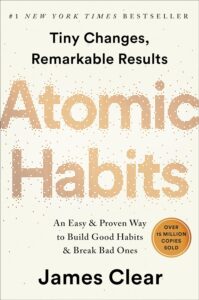What We’re Reading: “Atomic Habits” by James Clear
Atomic Habits by James Clear
How tiny changes produce remarkable results

Aristotle said, “We are what we repeatedly do. Excellence then, is not an act, but a habit.”
The fall season presents a prime opportunity for self-examination of our habits. As the leaves change colors, I often reflect on the passage of time and try to think of ways to turn over a new personal leaf to help make life better in some small way.
Such was my mood when I picked up the New York Times bestseller Atomic Habits by James Clear (2018). Billed as “an easy and proven way to build good habits and break bad ones,” I hoped it would help lead me down my own path of autumnal renewal.
Clear’s book is an enjoyable read. His prose is simple and impactful, and his framework for approaching “getting 1% better every day” is compelling.
A major premise of the book is that our dreams and successes are not built on massive actions or swift changes. Rather, they develop with a purposeful commitment to small changes – habits that we build into our daily routines. His advice then is really quite simple: focus on the system and steps you use to achieve your goals, rather than the goal itself.
Clear uses his own life story as the backdrop for his hyper-concentration on habits. As a sophomore in high school, he suffered a critical head injury when a bat hit his face during baseball practice. The injury landed him in a medically induced coma followed by months of rehabilitation.
But Clear didn’t give up on baseball. After two difficult years trying to reenter the sport, he turned over a new leaf in college where he “would discover the surprising power of small habits for the first time.” For example, he made it a habit to lift weights every day, keep his room tidy, and go to bed early. He attributes these small habits to his success in college as a scholar and an athlete.
Clear’s step-by-step guide for building better habits unfolds in four basic laws: make it obvious, make it attractive, make it easy, and make it satisfying.
One of my favorite pieces of advice he offers within this framework is called “habit-stacking” where you say, “After [current habit], I will [new habit].” The key to habit stacking is the specificity. It’s not enough, Clear suggests, to say, “When I take a break for lunch, I will mediate for one minute.” Instead, he recommends being more specific: “When I close my laptop for lunch, I will meditate for 60 seconds at my desk.” It is this focus on clarity (when, where and how long) that will help make the habit stick.
Clear’s book draws from biology, psychology, sports, business, and entertainment to create an easy-to-use operating manual for making small changes stick. Most importantly, these small changes can lead to big results over time. I truly enjoyed the book and hope you will, too!
